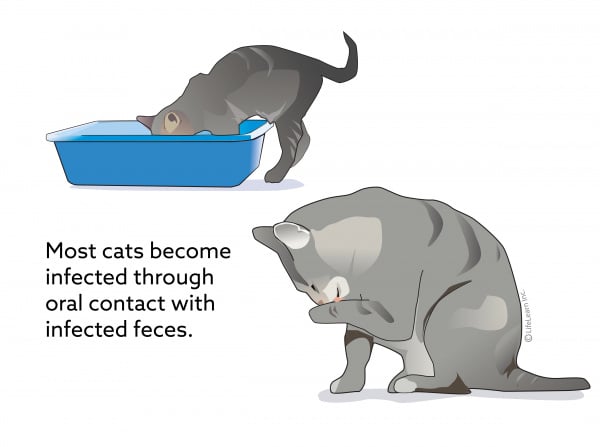"Feline infectious peritonitis (FIP) is an important disease of domestic cats. It occurs worldwide in cats of all ages, but the disease is most common in young cats less than two years of age. Although FIP is not a particularly common disease, it is important because once a cat develops the disease, the outcome is almost invariably fatal.
What is the cause of FIP?
FIP is associated with a viral infection called feline coronavirus. There are many different strains of feline coronavirus, which differ in their ability to cause disease. Previously there had been an attempt to classify these strains as either feline infectious peritonitis virus strains (capable of causing the FIP disease) or feline enteric coronavirus strains (essentially harmless strains mainly found in the intestinal tract). It is now recognized that feline enteric coronavirus strains can mutate (change) to the more harmful type of virus and cause FIP disease.
Diagnosing FIP is very challenging for many reasons. Unfortunately there are no laboratory tests available that can distinguish between the enteric coronavirus and the FIP-causing strains. Even when infected with known FIP-causing strains, many cats do not develop FIP disease. The factors determining why one cat becomes diseased while others remain unaffected are unclear. FIP remains one of the least understood of all cat diseases.
How does a cat become infected with feline coronavirus?
Most cats become infected with feline coronavirus through the fecal-oral route (oral contact with infected feces). It is estimated that about one-third of these cats shed the virus in their feces. Most cats only shed the virus for a few months, but a small percentage will shed the virus continuously for life. Although the virus is quite fragile and does not survive for more than 24-36 hours in the normal environment, it is believed that cold temperatures may preserve the virus for months. Transmission on clothing or other objects is only likely within a few hours of contact.
What age is a cat most at risk for developing FIP?
It is believed that most cats are exposed to feline coronavirus at a very young age, perhaps during the first few weeks of life. Most cats that develop FIP are between the age of 3 months and 2 years of age, although any age cat can develop the disease.
What clinical signs does a cat infected with FIP develop?
In cats that develop FIP disease, the first signs of illness may be very vague. Listlessness, lethargy, decreased or absent appetite, weight loss, and a fluctuating fever are commonly reported clinical signs. After a period of several days to a few weeks other symptoms typically begin to occur.
At this stage, most cats will develop the 'wet' or effusive form of FIP, which refers to the accumulation of fluid in body cavities; fluid may accumulate in the abdomen, leading to a swollen abdomen, or in the chest cavity, resulting in difficulty with breathing.
Some cats develop 'dry' or non-effusive FIP where little to no fluid accumulates. The dry form often involves severe inflammation in one or more organs including the eyes, brain, liver, intestine, or other organs of the body, leading to a variety of clinical signs. Many cats with non-effusive FIP will have ocular (eye) symptoms as their only clinical sign.
Once disease develops, most individuals deteriorate rapidly, although some cats remain normal for several weeks. Unfortunately, the disease will eventually result in death in almost every case.
Most cats exposed to feline coronavirus, even to the potentially FIP-inducing strains, are able to develop an immune response that protects them, therefore only a small proportion of infected cats actually develop clinical disease. However, as stated above, those that do develop the disease almost invariably die." *
* Text and image sourced from: https://vcahospitals.com/know-your-pet/feline-infectious-peritonitis






